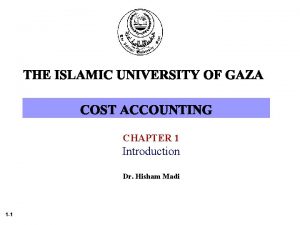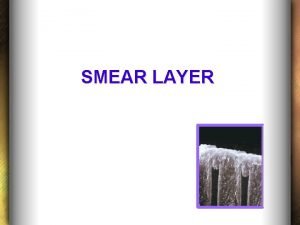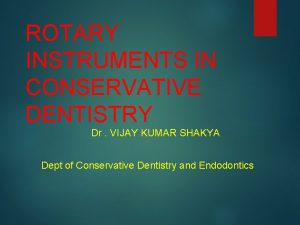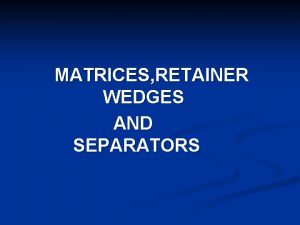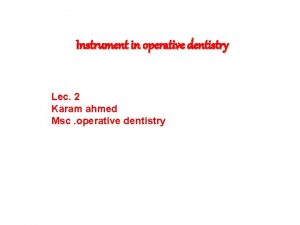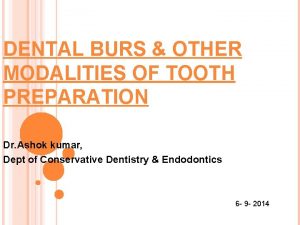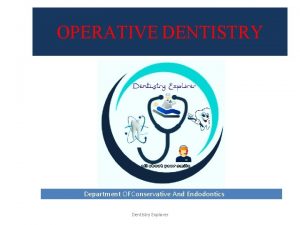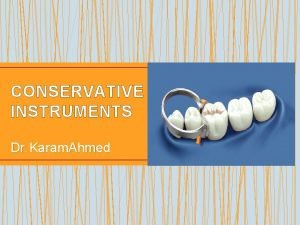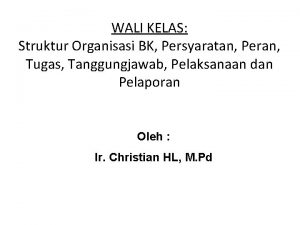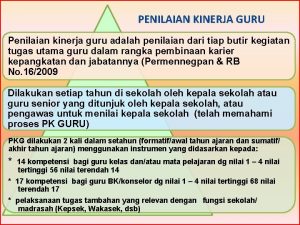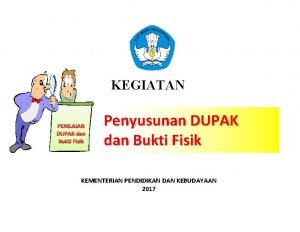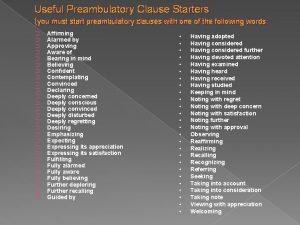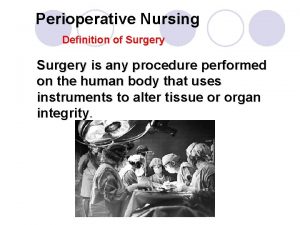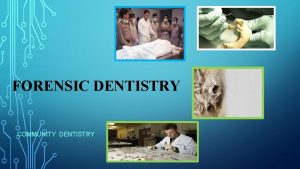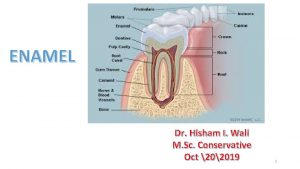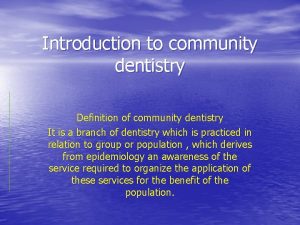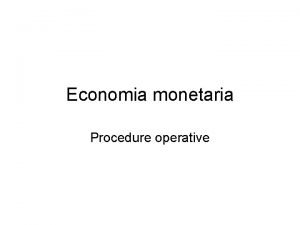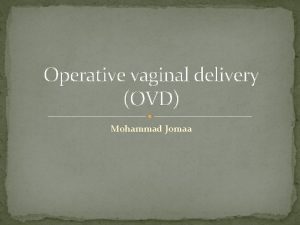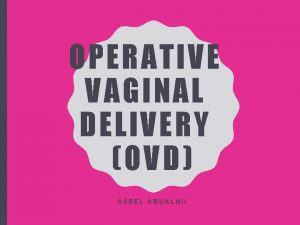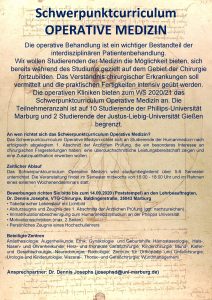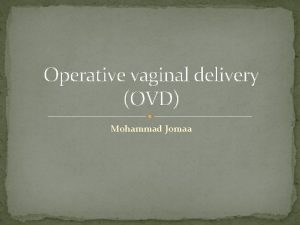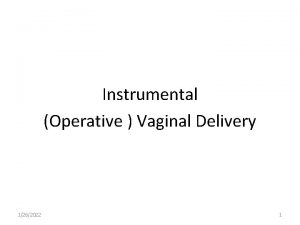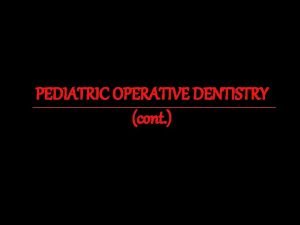INTRODUCTION TO OPERATIVE DENTISTRY Dr Hisham I Wali


























- Slides: 26

INTRODUCTION TO OPERATIVE DENTISTRY Dr. Hisham I. Wali M. Sc. Conservative Oct /13/2019 1

Introduction to operative dentistry 2

Operative dentistry is the foundation of dentistry from which other branches have evolved. It plays an important role in enhancing dental health and now branched into dental specialties. 3

How can we define operative dentistry? What is operative dentistry? Operative dentistry is that subject which includes diagnosis, prevention, and treatment of defects of the natural teeth, both vital and non vital, so as to preserve the natural dentition and restore it to the best state of health, function and esthetics. 4

History of operative dentistry In 1871, GV Black gave the philosophy of “extension for prevention”, for cavity preparation design. Dr. GV Black is known as the “Father of operative dentistry”. He provided scientific basis to dentistry because his writings developed the foundation of the profession and made the field of operative dentistry organized and scientific 5

Scope of operative dentistry includes the following: To know the condition of the affected tooth and other teeth To examine not only the affected tooth but also the oral and systemic health of the patient To diagnose the dental problem and the interaction of problem area with other tissues To provide optimal treatment plan to restore the tooth to return to health and function, and increase the overall well-being of the patient Thorough knowledge of dental materials which can be used to restore the affected areas To understand the biological basis and function of the various tooth tissues 6

Scope of operative dentistry To maintain the pulp vitality and prevent occurrence of pulpal pathology To have knowledge of dental anatomy and histology To understand the effect of the operative procedures on the treatment of other disciplines An understanding and appreciation for infection control to safeguard both the patient and the dentist against disease transmission 7

Indications of operative dentistry Dental caries Non carious lesions Malformed, traumatized & fractured teeth Esthetic improvement Repair of restorations 8

Indications of operative dentistry 1. DENTAL CARIES Dental caries is most common disease affecting the teeth. Dental caries is a microbiological disease of the teeth which results in localized dissolution and destruction of the calcified tissue, caused by the action of microorganisms and fermentable carbohydrates Based on anatomy of the surface involved, dental caries can be classified into the following types: 9

Indications of operative dentistry 1. DENTAL CARIES Pit and fissure carious lesions Smooth surface carious lesions 10

Indications of operative dentistry 1. DENTAL CARIES Root surface caries 11

Non-Carious lesions Indications of operative dentistry 2. NONCARIOUS LESIONS OF THE TOOTH STRUCTURE Attrition Abrasion Erosion 12

Indications of operative dentistry 2. NONCARIOUS LESIONS OF THE TOOTH STRUCTURE Attrition Mechanical wear of opposing teeth commonly seen on contacting occlusal and incisal surfaces 13

Indications of operative dentistry 2. Noncarious Lesions of the Tooth Structure Abrasion Loss of tooth material by mechanical wear other than contacting surfaces. It commonly occurs due to improper brushing of teeth 14

Indications of operative dentistry 2. Noncarious Lesions of the Tooth Structure Erosion Loss of dental hard tissue as a result of a chemical process not involving bacteria Acid induced erosion (e. g. , lemonsucking habit) 15

Indications of operative dentistry 3. MALFORMED, TRAUMATIZED, OR FRACTURED TEETH Traumatic injuries may involve the hard dental tissues and the pulp which require restoration 16

Indications of operative dentistry 4. ESTHETIC IMPROVEMENT Discolored teeth because of staining or other reasons look unesthetic and require restoration fluorosis stains 17

Indications of operative dentistry 5. REPLACEMENT OR REPAIR OF RESTORATION Repair or replacement of previous defective restoration is indicated for operative treatment 18

Indications of operative dentistry 6. DEVELOPMENTAL DEFECTS Defects like enamel and dentin hypoplasia, hypomineralization, amelogenesis and dentinogenesis imperfecta, tetracycline stains, peg-shaped laterals need operative intervention. 19 Amelogenesis Imperfecta Dentinogenesis Imperfecta

Diagnosis interception Operative dentistry deals with Restoration of the defects of natural teeth Prevention 20

OBJECTIVES OF OPERATIVE DENTISTRY Diagnosis is determination of nature of disease, injury or other defect by examination, test and investigation Prevention To prevent any recurrence of the causative disease and their defects, it includes the procedures done for prevention before the manifestation of any sign and symptom of the disease 21

OBJECTIVES OF OPERATIVE DENTISTRY Interception Preservation of the vitality and periodontal support of remaining tooth structure is obtained by preventive and interceptive procedures 22

OBJECTIVES OF OPERATIVE DENTISTRY Restoration Includes restoring form, function, phonetics and esthetics Maintenance After restoration is done, it must be maintained for providing service for longer duration 23

Development in Field of Operative Dentistry 24

Development in Field of Operative Dentistry Development of high-speed handpiece played a dramatic role in more conservative and efficient removal of tooth structure for restorative procedures Mechanical bonding to tooth structure by etching and dentin bonding has led to conservative bonding techniques Enhanced vision of the operative field while performing operative procedures by the aid of magnifying tools and devices like dental lenses, loupes and operating microscopes. Increased knowledge about carious process and beneficial effect of fluoride has laid emphasis on prevention of caries Increased research on dental biomaterials has led to vastly improved dental materials 25

26
 Dr. hisham khalil
Dr. hisham khalil Smear layer in dentistry
Smear layer in dentistry Rake angle in dentistry
Rake angle in dentistry Double wedging
Double wedging I wali
I wali Inverted pen grasp in dentistry
Inverted pen grasp in dentistry Dental bur design
Dental bur design Scope of operative dentistry
Scope of operative dentistry Conservative dentistry instruments
Conservative dentistry instruments Letak geografis kerajaan demak
Letak geografis kerajaan demak Patron anglii
Patron anglii Patron anglii
Patron anglii Wali qandhari
Wali qandhari Dua rukun nikah selain sighah
Dua rukun nikah selain sighah św dawid patron
św dawid patron Anovulation who classification
Anovulation who classification Struktur wali kelas
Struktur wali kelas Angka kredit wali kelas
Angka kredit wali kelas Tabel angka kredit guru
Tabel angka kredit guru Angka kredit wali kelas
Angka kredit wali kelas Gelanggang tuk wali
Gelanggang tuk wali Peranan wali sanga adalah....
Peranan wali sanga adalah.... Operative clause words
Operative clause words Translation text types
Translation text types Operative clauses examples
Operative clauses examples Post operative nursing management
Post operative nursing management Preoperative checklist definition
Preoperative checklist definition
